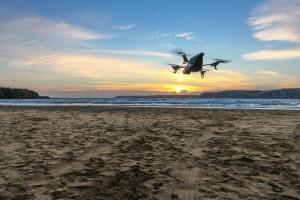WASHINGTON — For decades, research using drones was largely restricted to military applications. Now this tool for scientific revolution is becoming available to nearly everyone, from institutional researchers to citizen scientists and investigative journalists.
Regulations have not caught up, however. They still hold users of these unpiloted aerial vehicles, or UAVs, to many of the same requirements that apply to pilots of crewed aircraft.
“I’m as concerned as everyone else about making sure that people understand what they need to know legally,” said Rose Mooney, executive director of the Mid-Atlantic Aviation Partnership, during a Feb. 13 symposium at the American Association for the Advancement of Science (AAAS) annual meeting. “But having a full pilot certification doesn’t make sense for small unpiloted aircraft as it does for larger aircraft.”
The Federal Aviation Administration (FAA) is set to release new rules in June for these vehicles, also called unmanned aircraft systems. But it's unclear whether the changes will lead to more appropriate standards that spur UAV use in commercial and scientific applications.
Before UAVs joined the ranks of the most anticipated and affordable holiday gifts of 2015, remote-controlled flight in public was largely done by hobbyists who painstakingly built their own model aircraft.
“They loved aviation and knew all about it,” Mooney said. “Now, you don’t even have to know how to spell ‘aviation.’”
UAVs are now relatively affordable, with some small devices going for less than $100, and larger ones available for $500. This increased accessibility means many users will not necessarily be well-informed about the technology. This raises concern about reckless use, which, in turn, has bolstered regulatory restrictions. But if the legal frameworks improve, scientists will be better able to take advantage of the favorable prices in carrying out their research.
“The most important thing about UAV is that it’s a self-service model of investigation,” said Arizona State University professor Enrique Vivoni, who also spoke at the symposium. “This self-service model will revolutionize what we can do as scientists to understand modifications that human societies are making on our Earth and Earth’s systems.”
UAVs can provide data to “augment and amplify” 30 years of lower-resolution satellite imagery, Vivoni said. And, they can help keep researchers out of danger. Flying sensors low and slow over a landscape to gather ecological information is often unsafe work for pilots, and aircraft crashes are the leading causes of work-related deaths for wildlife biologists, according to a 2003 paper in the Wildlife Society Bulletin.
“UAV is an alternative to putting people in harm’s way,” Mooney said.
That is, if the devices are in the hands of people who operate them not just safely, but within legal limits.
“Any type of aerial surveillance, whether it's for news gathering or sensors that are picking up crops, have laws in place addressing privacy, use and distribution,” Mooney said. “Does everybody follow the laws? I think probably each one of us in this room has broken 10 laws today because there are so many we don’t even know about.”
Mooney helps manage one of six FAA UAV test sites and works with the government to try to ease restrictions that prevent many scientists, journalists, and hobbyists from flying the vehicles in U.S. airspace. Her team has partnered with 16 major news organizations to teach journalists how to legally use the vehicles. Last year, her group helped the Washington Post collect aerial video footage for a documentary on flood mitigation policy in New Orleans.
As the cost of flying decreases and federal regulations better align with scientific and commercial interests, the possibilities of unpiloted investigation will grow. And with this powerful tool at their disposal, scientists, journalists and others can better gather data needed to inform decisions about important social issues, from land use to disaster management.
The revolution is about “using information technology in real time to make better policy,” Vivoni said.
Billy Beaton is a senior Wildlife Biology major at the University of North Dakota. He is the co-founder of Sandbagger News, a video outlet that focuses on the human-environment relationship. Recently, he helped document the disappearance of the Western Meadowlark, the state bird of North Dakota.

